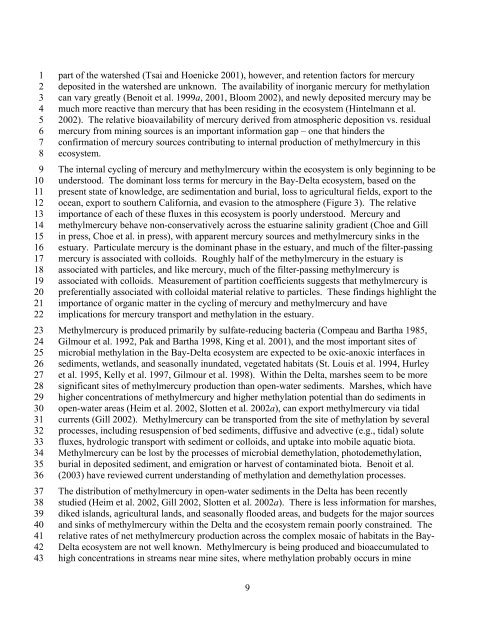Mercury Strategy for the Bay-Delta Ecosystem - CALFED Bay-Delta ...
Mercury Strategy for the Bay-Delta Ecosystem - CALFED Bay-Delta ...
Mercury Strategy for the Bay-Delta Ecosystem - CALFED Bay-Delta ...
Create successful ePaper yourself
Turn your PDF publications into a flip-book with our unique Google optimized e-Paper software.
1<br />
2<br />
3<br />
4<br />
5<br />
6<br />
7<br />
8<br />
9<br />
10<br />
11<br />
12<br />
13<br />
14<br />
15<br />
16<br />
17<br />
18<br />
19<br />
20<br />
21<br />
22<br />
23<br />
24<br />
25<br />
26<br />
27<br />
28<br />
29<br />
30<br />
31<br />
32<br />
33<br />
34<br />
35<br />
36<br />
37<br />
38<br />
39<br />
40<br />
41<br />
42<br />
43<br />
part of <strong>the</strong> watershed (Tsai and Hoenicke 2001), however, and retention factors <strong>for</strong> mercury<br />
deposited in <strong>the</strong> watershed are unknown. The availability of inorganic mercury <strong>for</strong> methylation<br />
can vary greatly (Benoit et al. 1999a, 2001, Bloom 2002), and newly deposited mercury may be<br />
much more reactive than mercury that has been residing in <strong>the</strong> ecosystem (Hintelmann et al.<br />
2002). The relative bioavailability of mercury derived from atmospheric deposition vs. residual<br />
mercury from mining sources is an important in<strong>for</strong>mation gap – one that hinders <strong>the</strong><br />
confirmation of mercury sources contributing to internal production of methylmercury in this<br />
ecosystem.<br />
The internal cycling of mercury and methylmercury within <strong>the</strong> ecosystem is only beginning to be<br />
understood. The dominant loss terms <strong>for</strong> mercury in <strong>the</strong> <strong>Bay</strong>-<strong>Delta</strong> ecosystem, based on <strong>the</strong><br />
present state of knowledge, are sedimentation and burial, loss to agricultural fields, export to <strong>the</strong><br />
ocean, export to sou<strong>the</strong>rn Cali<strong>for</strong>nia, and evasion to <strong>the</strong> atmosphere (Figure 3). The relative<br />
importance of each of <strong>the</strong>se fluxes in this ecosystem is poorly understood. <strong>Mercury</strong> and<br />
methylmercury behave non-conservatively across <strong>the</strong> estuarine salinity gradient (Choe and Gill<br />
in press, Choe et al. in press), with apparent mercury sources and methylmercury sinks in <strong>the</strong><br />
estuary. Particulate mercury is <strong>the</strong> dominant phase in <strong>the</strong> estuary, and much of <strong>the</strong> filter-passing<br />
mercury is associated with colloids. Roughly half of <strong>the</strong> methylmercury in <strong>the</strong> estuary is<br />
associated with particles, and like mercury, much of <strong>the</strong> filter-passing methylmercury is<br />
associated with colloids. Measurement of partition coefficients suggests that methylmercury is<br />
preferentially associated with colloidal material relative to particles. These findings highlight <strong>the</strong><br />
importance of organic matter in <strong>the</strong> cycling of mercury and methylmercury and have<br />
implications <strong>for</strong> mercury transport and methylation in <strong>the</strong> estuary.<br />
Methylmercury is produced primarily by sulfate-reducing bacteria (Compeau and Bartha 1985,<br />
Gilmour et al. 1992, Pak and Bartha 1998, King et al. 2001), and <strong>the</strong> most important sites of<br />
microbial methylation in <strong>the</strong> <strong>Bay</strong>-<strong>Delta</strong> ecosystem are expected to be oxic-anoxic interfaces in<br />
sediments, wetlands, and seasonally inundated, vegetated habitats (St. Louis et al. 1994, Hurley<br />
et al. 1995, Kelly et al. 1997, Gilmour et al. 1998). Within <strong>the</strong> <strong>Delta</strong>, marshes seem to be more<br />
significant sites of methylmercury production than open-water sediments. Marshes, which have<br />
higher concentrations of methylmercury and higher methylation potential than do sediments in<br />
open-water areas (Heim et al. 2002, Slotten et al. 2002a), can export methylmercury via tidal<br />
currents (Gill 2002). Methylmercury can be transported from <strong>the</strong> site of methylation by several<br />
processes, including resuspension of bed sediments, diffusive and advective (e.g., tidal) solute<br />
fluxes, hydrologic transport with sediment or colloids, and uptake into mobile aquatic biota.<br />
Methylmercury can be lost by <strong>the</strong> processes of microbial demethylation, photodemethylation,<br />
burial in deposited sediment, and emigration or harvest of contaminated biota. Benoit et al.<br />
(2003) have reviewed current understanding of methylation and demethylation processes.<br />
The distribution of methylmercury in open-water sediments in <strong>the</strong> <strong>Delta</strong> has been recently<br />
studied (Heim et al. 2002, Gill 2002, Slotten et al. 2002a). There is less in<strong>for</strong>mation <strong>for</strong> marshes,<br />
diked islands, agricultural lands, and seasonally flooded areas, and budgets <strong>for</strong> <strong>the</strong> major sources<br />
and sinks of methylmercury within <strong>the</strong> <strong>Delta</strong> and <strong>the</strong> ecosystem remain poorly constrained. The<br />
relative rates of net methylmercury production across <strong>the</strong> complex mosaic of habitats in <strong>the</strong> <strong>Bay</strong>-<br />
<strong>Delta</strong> ecosystem are not well known. Methylmercury is being produced and bioaccumulated to<br />
high concentrations in streams near mine sites, where methylation probably occurs in mine<br />
9

















